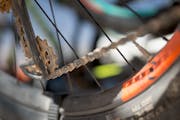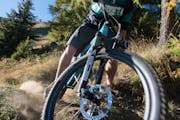Ruedi Thomi, Jonas Jäggy
You might not be bothered if your bike’s a bit dirty, but keeping the chain, screws and sprocket wheel clean helps to prolong their service life. We reveal how to clean your bike in just a few steps.
Bike rides along gravel paths and country lanes, the edge of a forest or even just on the road all leave their mark on your bike. You might not be bothered by dust and dirt, but your chain and other components are, as dirt is abrasive. It causes parts to wear quicker and leaves them needing repairs sooner.
How frequently you clean your bike depends how often you use it and on what surfaces. A mountain bike you ride off-road, for instance, should be given a quick clean after every trip. If you only cycle your bike on the roads, a monthly cleaning is probably plenty.
What you need to clean your bike
The following instructions for cleaning your bike relate to commonly used models and components. However, they may not apply to all bikes. If you’re not sure, your bike’s instruction manual might contain specific information. Otherwise, ask at a workshop.
You need the following to clean your bike:
Brush, sponge, cloth
Bike cleaner
Chain oil
Small toolkit (with torx bits)
Air pump with pressure gauge
Small torque wrench (up to approx. 12 Nm)
Additionally, for bikes with suspension: suspension pump and suspension fork spray
Cleaning your bike – here’s how

Basic clean
First, use water to remove the bulk of the dirt. Then, use a sponge and bike detergent to perform a more thorough clean. Dry everything off well with a cloth.
Caution: don’t use a pressure washer! They can damage your bike’s bearings and seals.

Chassis
Clean the fork and dampers with a clean cloth. To lubricate the wiper rings, you can apply a suspension fork spray on the standpipe. Then, use a suspension pump to check the air pressure in the fork and dampers. For a mountain bike, a negative sag (often expressed as a scale) of around 25 percent is desirable.

Gears
Give the pinions, chain ring guard, chain and gear shift a thorough clean with a small brush and cleaner. Apply a small amount of chain oil, then switch through all the gears a couple of times and wipe away any excess oil. If the gears stick, you can adjust them by using the screw.

Tyres
Check the tread. Are the tyres worn down? If so, you must get new ones: worn-down tyres are a safety risk! Check the pressure: the target value, in bar, is printed on the tyres. For mountain bikes, you should start with around 2.0 bar and then gradually reduce the pressure to get maximum grip.

Brakes
Check the pads, shoes and discs. The coating on the carrier plate should be at least a millimetre thick, but check this against the manufacturer’s specifications. If the coatings have worn off, you need new ones. And if your brakes aren’t gripping as well as they used to, you might need to bleed them. To do this, seek out someone with experience or a professional.

Screws and bearings
Check all the screws and tighten them up with a torque wrench: the Nm details are often printed on the components. If not, you can find it in your bike’s instruction manual. For fullies: check whether the bearings have room to move around. If they do, have them checked in a bike workshop; otherwise, it can result in further damage.
Share the articleHow to clean your bike properly
- Free shipping from CHF 99
(With the TransaCard always free of charge)
- Secure payment with Twint, Visa and more
- 14 days cancellation right


